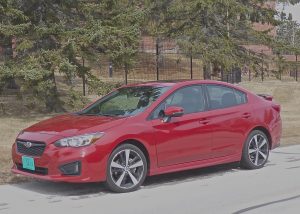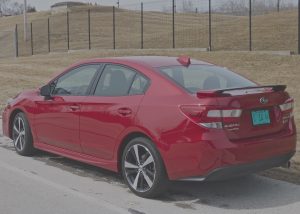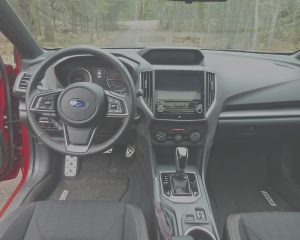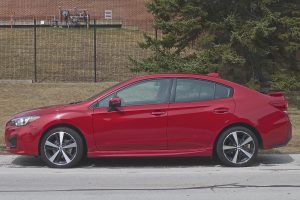New Impreza hidden in plain view
By John Gilbert
After pulling into the Target parking lot, I dropped off my wife, Joan, and engaged in my usual parking-lot gamesmanship, wherein I circle a couple of times just to see if I can find a closer-than-reasonable open spot near the store. I don’t mind the extra walk distance; it’s just a competitive game I like to play. In this case, I found one, and nosed my “Lithium Red Pearl” compact into the slot.
There was some sort of a sports discussion on the radio, so I sat there for a few minutes. A family parked its SUV and walked past. The fellow carrying a youngster turned back once, and then a second time, for a longer look. Then he smiled and walked on.
Another couple came by, same sort of thing. Both of them paused for a second look before continuing on. Later, at another parking space in downtown Duluth, Minnesota, a couple guys walked by and stopped. “What kind of car is that?” asked one.
“It’s the new Subaru Impreza,” I answered.
“You’re kidding,” he said. “Doesn’t look like any Subaru I’ve ever seen before.”
It’s hard to recall any Subaru sedan attracting that sort of interest from passers-by. But this is the new 2017 Subaru Impreza, which is like no other previous Impreza sedan.
This one is built on an all new Subaru Global Architecture platform, upon which all things Subaru from here on will be built, because it can house everything from a sports car to an SUV. Until a company revises, restructures and reinforces its mainstay platform, consumers never have reason to realize the need for such upgrading.
With the new Impreza, Subaru is claiming that the new car is 70 percent more rigid than the 2016 was. Think about that. It’s not like you drove the 2016 and thought of it as a piece of ill-fitted junk. It felt OK. Beyond that, it felt the way you anticipated a Subaru Impreza should feel. If a compact sedan can become 70 percent more rigid than last year’s, consider what would happen in reverse, and what any car would feel like if you reduced its rigidity by 70 percent!
In any event, maybe it takes the firmness of the new platform to force you to realize how impressive it feels because now you’re aware of how ragged and inconsistent previous Imprezas handled, rode, and steered.
Underneath, all is changed now, much in the same way the visual impact of the Impreza has completely changed. Passers-by were taken by the metallic red paint job, but more by how it looked when draped on the stylish contours that indented the sides and slanted upward near the rear wheelwells. Those lines came off a smoothly coordinated grille and hood, and ended at a stylishly turned rear decklid and incorporated taillights. Length of 182.1 inches and wheelbase of 105.1 means the stretching makes room for 12.3 cubic feet of cargo.
The test car, a 2.0i Sport model, tracks well, and its 2.0 flat-opposed 4-cylinder kicking out 152 direct-injected horsepower and 145 foot-pounds of torque. It also had a CVT — continuously variable transmission — which handles the 3,179-pound compact sedan with ease, and even establishes a sporty feel with steering-wheel paddles that can engage different detents to feel like a 7-speed transmission.
Partly because the flat-opposed engine’s direct injection increases power a bit, and partly because its new steering geometry andspecially-damped suspension reduce the body’s tendency to roll by a full 50 percent, but mostly because of that all-new platform, the Impreza makes those sporty alloy wheels look like they are not out of place.
Functionally, the sport-tuned suspension and active torque-vectoring helps stability for that symmetric all-wheel drive, and the nose features active grille shutters that can close at cruising speed to aid aerodynamics.
Inside, the seats are well-bolstered and comfortable, and because the car is a bit longer and wider, there is room for adults to fit more comfortably in the rear seat, where many compacts make that a challenge. Two-stage heated front seats and leather-wrapped steering wheel and shift knob are nice touches, as are the aluminum pedals. Keyless access and push-button start are almost mandatory these days, so it’s impressive the Impreza has them. It also has a windshield that is thicker for sound insulation, and the power moonroof and added feature of tire-pressure monitoring with individual pressure display means Subaru checked all the boxes.
The interior finish is also vastly improved, including the nav screen, which is an 8-inch high-resolution touchscreen, as part of the Starlink Multimedia Plus system, which affords easy connectivity for Apple, Android, Aha, Pandora, Bluetooth choices of hands-free devices. The driving control instruments, with knobs and controls easy to spot and efficient to operate, have redundant controls on the steering wheel, and little storage cubicles seem to be everywhere you’d want them, to make things easier to live with.
EyeSight driver assist lifts the new Impreza to the upper echelon of compacts with adaptive cruise, pre-collision braking, lane-departure and sway warning, plus lane-keep assist, lane change assist, and rear cross traffic alert.
Perhaps most impressive, Imprezas always have been inexpensive, which makes the new one seem like much more of a bargain, at a starting price of just over $21,995 for the Sport model. Option packages including the EyeSight, moonroof, Harman/Kardan audio upgrade, and Lineartronic CVT boost the sticker up to $26,560.
Does it blow away the main competition, such as Mazda3, Honda Civic, or Hyundai Elantra? In a word: No. But it now competes with them, with no apologies.
The high-performance WRX always has been an impressive premium version on the Impreza line, and the very top WRX STi is an outright screamer. Those will continue on the old platform, we’re told, for now. I would have to say, as fun as those cars are, they are nowhere near as refined as the new garden-variety Impreza, which means Subaru should hasten to get them on the new platform.
In assessing all the high points, we can point at the comfort, space, flexibility of its hatchback storage space, and now the precision noteworthy in its steering and handling, and its outright lack of shakiness that used to be standard equipment in Imprezas.
Plus, I would have to go back to my parking lot experiences, and a week of other passers-by pausing to look or comment as best evidence of how slick the new Impreza looks. It can baffle onlookers who can’t figure out what it is without asking. It simply doesn’t look like a Subaru Impreza because there is nothing odd or irregular about how it looks or how it drives. And that’s a good thing.







 John Gilbert is a lifetime Minnesotan and career journalist, specializing in cars and sports during and since spending 30 years at the Minneapolis Tribune, now the Star Tribune. More recently, he has continued translating the high-tech world of autos and sharing his passionate insights as a freelance writer/photographer/broadcaster. A member of the prestigious North American Car and Truck of the Year jury since 1993. John can be heard Monday-Friday from 9-11am on 610 KDAL(www.kdal610.com) on the "John Gilbert Show," and writes a column in the Duluth Reader.
John Gilbert is a lifetime Minnesotan and career journalist, specializing in cars and sports during and since spending 30 years at the Minneapolis Tribune, now the Star Tribune. More recently, he has continued translating the high-tech world of autos and sharing his passionate insights as a freelance writer/photographer/broadcaster. A member of the prestigious North American Car and Truck of the Year jury since 1993. John can be heard Monday-Friday from 9-11am on 610 KDAL(www.kdal610.com) on the "John Gilbert Show," and writes a column in the Duluth Reader.